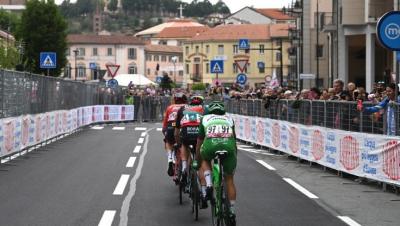Fierce mountain battle in Giro d'Italia

BRUSSELS -- Friday’s 13th stage of the Giro d'Italia cycling race from Borgofranco d’Ivrea to Crans Montana was to be the first mountain stage. It would have taken the peloton through the Alps to Switzerland. The stage was designed as the tour’s hardest and all experts anticipated a fierce battle between the general contenders.
The impressive “Col du Grand Saint-Bernard”, a climb which takes the riders to an altitude of 2.500 metres, was the main challenge. Yet a couple of days earlier, heavy snowfall and the risk of avalanches had persuaded the Giro organisation to change the stage’s itinerary: instead of climbing up to the top, the participants would pass a tunnel situated 600 metres below the top.
Thursday evening, however, the “Cyclistes Professionnels Associés” syndicate asked the Giro organisation to apply the Extreme Weather Protocol and to drop a mountain: the “Croix de Coeur.” Besides freezing temperatures -atop this mountain it would be 3°C- ice on the road would make its descent outright perilous.
When Friday morning the roads in Borgofranco d’Ivrea were flooded, the organisation communicated the final version of the itinerary: stage 13 would start in Le Chable, Switzerland. The “Col du Grand Saint-Bernard” would no longer made part of the stage. Though shortened to a mere 74 kilometres and stripped of the higher mountain, there would still be 27 kilometres uphill. Two so-called climbs of first category remained: the “Croix de Coeur” and the “Crans Montana”.
The Crans Montana is a classic in the heavy Tour of Switzerland and ditto “Tour de Romandie”.
The “Croix de Coeur”, with its 15,4 kilometres at an average gradient of 8.8%, would fit Primož Roglič like a glove. Slovene Roglič arguably is the world’s most efficient puncher and he is second in the general classification at barely two seconds from leader Geraint Thomas.
As could be expected, the climbers immediately took their chance. Ecuadorian cyclist Jefferson Cepeda was the first climber to break away from the peloton. Nine cyclists, among which French climber Thibaut Pinot, soon joined him. After the peloton caught the group, Cepeda again broke away, followed by Pinot and Colombian Einer Rubio. French cyclist Aurélien Paret-Peintre, afraid to lose his top 10 spot to Pinot, also hurried to join the leading group.
When Pinot accelerated, only Cepeda, Rubio and Canadian cyclist Derek Gee could follow. Pinot asked Gee to do his share but the latter refused. In the descent, Paret-Peintre again joined them. Contrary to other cyclists, he took a lot of risk -especially the first kilometre beyond the top contained numerous potholes. On a bike which weighs about 7 kilograms and whose tyres are between 23 and 28 millimetres wide, Paret-Peintre descended at a speed up to 94 kilometres/hour!
On the final climb, the “Crans Montana”, Pinot incessantly attacked. Only Rubio and Cepeda could follow. After Pinot had reprimanded Cepeda for not doing his share, the climb became a duel between the French and the Ecuadorian. Though Pinot being the stronger cyclist, it was Rubio who would finally win the stage. On the verge of retiring from professional cycling, Pinot had made about all the mistakes a beginning cyclist can make. Though Pinot did not win the stage, he entered the general classification’s top 10, replacing his fellow countryman Paret-Peintre.
With regards to the general classification, stage number 13 did not bring the fireworks it had been expected to bring. Overall leader Geraint Thomas had made his team mates De Plus and Arensman keep Pinot’s lead limited. Finally, the numbers one and two and three crossed the finish line in the same group.
jp-md
© COPYRIGHT ITALIAN INSIDER
UNAUTHORISED REPRODUCTION FORBIDDEN


